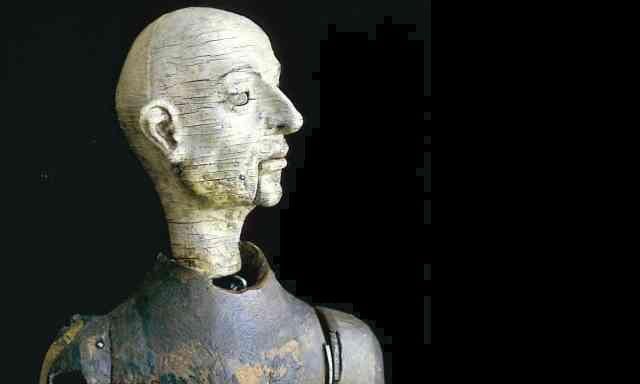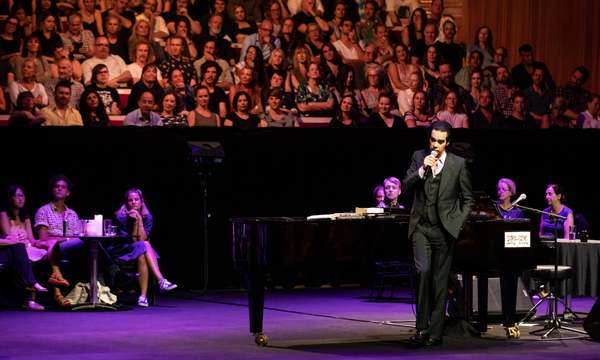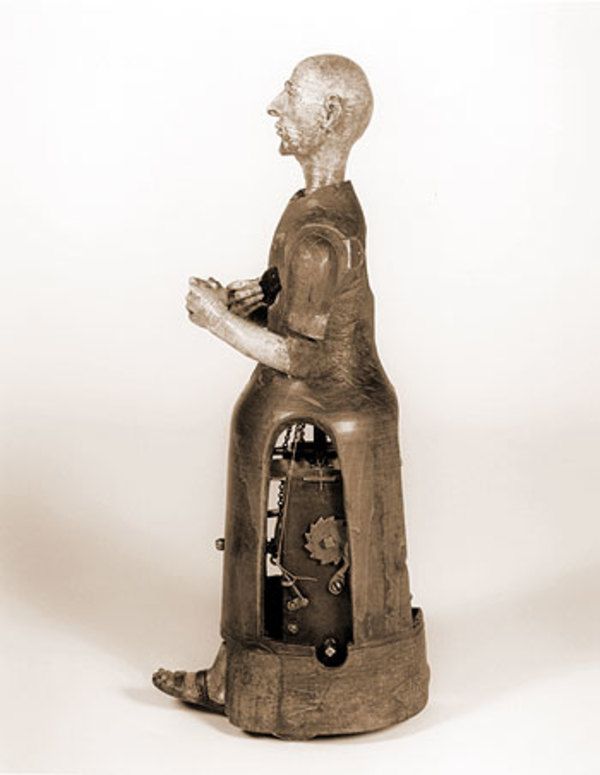A machine for hammering the soul, with robotic Padres

It’s a juicy weekend read for you, in defence of piety (!)…
📖📖📖
After taking an extended break from social design work “to get some perspective” (ahem), I find that Everything Now Looks Very Strange Indeed™. This is another one of my updates on restarting a creative practice, with added cultural and design commentary.
(If someone’s forwarded this thing to you in the hope you’ll find it interesting, you can subscribe here to secure my everlasting love.)
Today I want to write of vibrations of the soul, the experience of the divine and the habit of prayer. With robots. Yes.
I remain a staunch unbeliever, and yet I find that these apparently religious terms become more useful when I’m wrestling with certain practices: of creativity, of recovery, of becoming a better participant in my communities (local or cosmic). Each of these requires me to paradoxically affirm my own sense of agency by simultaneously curbing it.
For example, working on our addictions is never simply a matter of exerting our individual willpower (which is called “white-knuckling it” in recovery culture, and clearly unsustainable); we instead need to make the choice to surrender to the collective agency of community.
And the other week, my dear friend Janelle and I attended a writer’s meetup that involved everyone sitting down and just doing some fucking writing. As we sat in a zero-ambience pub bistro, beavering away, she passed me a note:
“THIS FEELS FORCED AND NOT RAD.”
Agreed, the venue was very much not rad, and we weren’t a very inspiring sight, but to be fair to the rest of us, Janelle’s own writing is driven by uncommonly strong affective tides that would wreck a less glorious being. I’d argue that for most people, sustainable creativity needs in some way to be “forced”, and this isn’t a bad thing. My own creative endeavours need to be sustained by the scheduled habit of accessing an animating spirit that might reveal itself to the solidarity of a congregation. (It does need a better venue, though. Blech.)
Such appeals to the beyond have given me a new, practical appreciation of the rigours of piety. But lest I be accused by Slavoj Žižek of some lacklustre, postmodern, liberal-secular appropriation of spirituality, I need to leaven this stuff with a good dose of machines and robots to keep it interesting to me. 😉
Eternal return: burials, and when the earth rejects us
First, some follow-up.
Did you know that in this wonderful medium of email newslettering, you can simply reply to any of these missives from me, and that your reply will appear directly in my everyday, personal email inbox? It’s real email. No really, I love this, so replies are encouraged. Meanwhile, I’m really heartened by the generous messages I’ve received from you thus far. Also, I don’t know some of you, and this mixture of the known and unknown is tantalising.
Answering my call in the last issue for objects that deserve “burial rites/rights" with us, Andrew (who I know can light a fire with his bare hands) replies that “I would bring with me a wooden spoon for my cooking, a headlamp for reading late at night and camping, and a vr headset because I know I won’t be affording one in this lifetime”. That would just be a simulated, still life VR headset then, right?
And Deborah, who wants “to be buried with seeds inside me, so I could be compost” (and who also first pointed me in the direction of socially responsible design, many years ago 😘), also notes that the word “Pandæmonium”, which I used in my last missive to describe the experience of the classroom in the context of exploring All the Things, “was coined to describe the Place Of All The Demons” — the capital of Hell in Milton’s Paradise Lost. So oddly… appropriate.
Deborah also pointed me to “When the rocks turn their backs on us”, Ken Wark’s review of Elizabeth Povinelli’s Geontologies: A Requiem to Late Liberalism:
[T]he Anthropocene is far from being some hubristic discourse about the powers and destinies of Man. It is rather a malignant, viral human presence in geological time. I think here one could read the Anthropocene through the figure of immunity rather than community. It is not the figure of Man becoming sovereign over the community of the biosphere within geological time. It is rather the biosphere immunising itself against forms of (non)life that it can’t endure.
While I think there’s every reason to despair, this feels a little too enthusiastically misanthropic. (Perhaps Wark is trying to make up for his embarrassing social democratic excesses of the ‘90s.) Not all community is naturalistic, hippy-dippy togetherness and accommodation, and the pain of recognising and negotiating it, against the predations of capital, might offer a bleak kind of hope. I shall ponder. I’ve naturally procured Povinelli’s book and will report back in a future issue.
⚒️🎵 The Hammer Song

Kandinsky’s "Winter Landscape", 1911
The Masters of Modern Art from the Hermitage show could so easily have drifted into Adult Contemporary Viewing territory, but it brought me this amazing quote from Kandinsky:
Colour is the keyboard, the eyes are the hammers, and the soul is the piano with many strings. The artist is the hand that plays, touching one key or another, to cause vibrations in the soul.
The eyes are the hammers. Whoa. Despite its manifest spiritualism, this image builds a model of aesthetics that’s all about resonant, relational assemblages of awesome in which each actor plays a material part. My eyes and yours live together inside a big piano. Fucking yes. This is society and ecology, defined — via aesthetics. The exhibition leaves Sydney this weekend if you want to catch it.
🔪🥀 Nick Cave is a joyful robot monk. Wait, what?

Nick Cave in conversation. Photo filched from Daniel Boud.
I was grateful to be at Conversations with Nick Cave the other week, not just to hear Cave’s voice and solo piano really rise to the occasion and fill a venue with their resonance, but to see the open Q&A format of the show return repeatedly to Cave’s creative process.
Fans who might’ve been clamouring for transcendent tales of sudden inspiration, or 19th Century Gothic influences (“I don’t have any”), were brought back to earth by the familiar refrain of the committed creative professional: Cave shows up to work, which requires lots of meticulous preparation and backbreaking iteration, and he makes it happen. “It’s a job,” he said, with finality. (I love the incongruity of this stuff coming from people like Nick Cave, or Bobbie Gillespie, who apparently keeps office hours for Primal Scream.)
But I’ve become a little sceptical of the total demystification of creativity that’s now common in our algorithmically inclined age of, uh, content-marketing savvy. With our era’s overly instrumentalist promotion of a well-adjusted creative-entrepreneurial mindset, it might be all too easy these days to reduce everything to using elbow grease to, you know, hit targets.
So I love that Cave is still in awe of sacred aesthetic magic when his rigour allows it to happen. He talked of putting in the work so that the divine can arrive. All his meticulous “going through the motions” (again, not a bad thing) produces something more than the sum of those motions. For him, it’s a way to experience God. And despite his Prince of Darkness reputation, Cave was at pains to describe how joyful that process can be. “There’s nothing dark about it.”
🤖🙏 Oh yeah, the bit about robots
When I was listening to Radiolab the other day (despite my long-running ambivalence about the show), I found that this recent episode’s focus on robots of antiquity resonated unexpectedly with my reading of Nick Cave’s creative process.
Hear me out.
In 1562 the crown prince of Spain, Don Carlos, falls down a flight of stairs and sustains a head injury that is by all accounts going to be fatal. According to Radiolab, his father King Philip II “kneels at his son’s deathbed and makes a pact with God: ‘If you help me, if you heal my son — if you do this miracle for me — I’ll do a miracle for you.’”
Don Carlos miraculously survives, apparently thanks to the intervention of the spirit of Diego de Alcalá, a celebrated monk who died a century before. And so now Philip II needs to somehow perform his miracle:
[He] enlists a really renowned clockmaker named Juanelo Turriano — a huge ox of a man, described as always being filthy and blustery and not a lot of fun to be around — but a great, great clockmaker. So the king says, “Look, I want you to make a mechanical version of Diego de Alcalá, a mechanical version of this 100-year-dead holy priest. Yes, a mechanical monk — a robotic padre.”

The robotic padre
Artist and historian Elizabeth King describes the result:
Driven by a key-wound spring, the monk walks in a square, striking his chest with his right arm, raising and lowering a small wooden cross and rosary in his left hand, turning and nodding his head, rolling his eyes, and mouthing silent obsequies. From time to time, he brings the cross to his lips and kisses it. After over 400 years, he remains in good working order.
A miracle of technology! (You can watch a very low quality video of the robot in action here.) “He walks a delicate line between church, theatre, magic, science,” King writes, pondering the significance of the mechanical monk. “Here is a machine that prays.”
What does it mean? According to King and Radiolab, in the context of Counter-Reformation Spain, the robot monk strikes to the heart of debates about how one gets close to God:
You have the Protestants, with Luther, who are saying, “it’s not about works … it’s about whether you feel it.” And then you have the Catholic argument which is to say you do these rituals because these are the rituals, and this is the way you get close to God.
The robot monk teaches us how to do ritual. Controversial! Given the ridiculous degree of crufty observance and corruption in the Church at the time of the Reformation (and, um, other times), I obviously understand why the Protestant appeal to pure feels was compelling. But my own ingrained Catholic social justice calculus of “good works” aside (“don’t fucking tell me your account with God hinges on how you feel inside instead of your concrete actions in the world, you schismatic apostates!”), I can’t help but think that this debate, and the robot monk himself, is a metaphor for the observance of creative process.
As stated above, I’m suspicious of the reduction of creativity to a bunch of instrumental observances in the mechanised pursuit of… metrics. Hack-work content marketing success, paid in SEO indulgences to the Church of Google. But to respond to this by abandoning the rigours of creative process for the inspiration of pure feeling would be a mistake. Unless you’re a tidal wave like my friend Janelle, feelings are fickle. Protestant churches tend to trade the horrific institutionalised power of the Catholic Church (about which we need no reminders) for another kind of tyranny: exploitative emotional economies in which the faithful tend to be at the mercy of charisma. And to trade in pure charisma is to produce strongmen. As our current times remind us, charismatic populism offers release for the anxious but also destroys the processes that ultimately help us flourish as communities. Creative populism that relies on emotional catharsis tends to destroy the basis for a consistent creative practice. Just as the Reformation ended up eliding the point of what “good works” might potentially be about (i.e. acting rigorously to enable the arrival of goodness), we also need to remember what creative rituals are for (i.e. exactly the same thing as good works).
Thus it is with Nick Cave, who for me is the amazing robot monk. He mightn’t be your cup of tea, or you might even find his work occasionally objectionable, but I think most of us can agree that his creative practice really hums. (Don’t let his obsession with Southern Baptists or his own Anglican heritage distract. In terms of process, he is an exemplary Catholic robot.) He prepares, meticulously. He shows up to work. He performs the motions regularly, not worrying about inspiration, and through these observances somehow accesses what he feels to be a divine and joyous experience of creativity.
I’m convinced that if Nick Cave relied on pure feeling, or murderous inspiration, or spontaneous gothic possession, or any of the other assumptions people make about his artistic persona, so many great moments of his oeuvre wouldn’t exist. Nick Cave walks the square and kisses the cross and talks to God. For he is a joyous robot monk.
🎼 Coda
For those of you who remain unconvinced by my yoking together of monks and murder ballads: the final line of Umberto Eco’s The Name of the Rose, an historical murder mystery set in a monastery, is “Stat rosa pristina nomine, nomina nuda tenemus”, or “The rose of old remains only in its name; we have only naked names”.
Meanwhile, I was never really a fan of the chorus of “Where the Wild Roses Grow,” Cave’s duet with Kylie Minogue:
They call me The Wild Rose
But my name was Elisa Day
Why they call me it, I do not know
For my name was Elisa Day
Oooh. The name of the rose. Anyway, to me, Minogue’s delivery always reeked of passive fatalism. But the other day, I realised that it wasn’t fatalistic all — it was full of spooky reproach. Elisa Day remains known to us by her Wild Rose name of legend, but her ghost insists on remembering her own name. She’s crossing t’s and dotting i’s from beyond the grave.
Following Kylie, we would do well to pay proper respect to the names of those who are in the beyond. The way we relate to them constitutes its own assemblage, its own machine of observances. In this I’m reminded of Arthur C. Clarke’s 1953 short story, “The Nine Billion Names of God”, in which Tibetan monks manage to automate the process of transcribing all the permutations that God’s name can take, using a supercomputer (naturally). Observing the names is the universe’s purpose, you see. And when the final name is encoded… Whoa.
How’s that for a crazy constellation? (I know I’m just reaching. But it’s fun!)
A sustainable portion of all my love,
Ben
